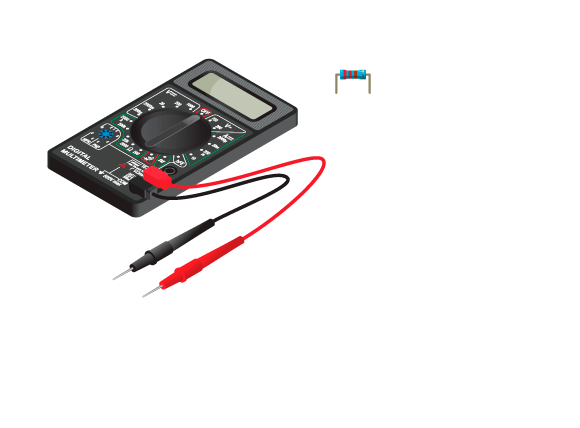A multimeter is an instrument used to measure current, voltage, and resistance. You can read more about the relation between these under resistors and Ohm’s law. You will go through three examples of when to use the multimeter. The multimeter consists of a display for data, a knob for selecting the type of measurement, and two pointed sensors used to touch the parts you want to check. The black cable, by convention, should always be plugged into the slot marked ‘COM’ as in ( or ground). In all three examples below, the red cable should be plugged into the slot marked ‘V’, as in voltage.
Continuity
When you test for continuity, that is if current is flowing through a circuit, you want to make sure that a wire you are using is intact or that there are no shorts in the circuit.
Materials

- 1 multimeter
- 1 jumper wire
Instructions

- Turn the knob to the sound icon.
- Take the two pointy cables and touch their ends together. You will hear a beep meaning that there is a closed circuit.
- Take a jumper wire and the two multimeter cables. Touch the two ends of the cables to the ends of the wire. Most likely, the multimeter will beep. If it does not, that means the wire is broken.
If you have soldered a circuit together, but it is not working for some reason, this is a good way to start troubleshooting. By checking all the soldered connections, you can make sure that the circuit is closed where it should be and that there are not any connections where there should not be.
Resistance
If you can not remember the color code of the resistors by heart, you can measure the resistance with the multimeter.
Materials

- 1 multimeter
- 1 resistor of any resistance
Instructions

- Turn the multimeter knob to the side marked with the Ohm sign. Start by turning it to the lowest value, which is 200 ohm. That value means that you can measure resistance up to 200 ohm.
- Touch each side of the resistor with the tip of the cables. If the display reads ‘0.L’, that means that the resistance is greater than what you have set the multimeter to check.
- Turn the knob to the next level, and touch the resistor legs with the cables again. Keep turning the knob until you can read a number on the display. If the knob is set to ‘20k’ and the display says ‘10.0’ this means that the resistance is 10k ohm.
Voltage
This example will show you how to measure the voltage across a potentiometer. The potentiometer you will use has a range from 0V to 5V.
Materials

- 1 multimeter
- 1 Arduino Uno
- 1 Education shield
- 1 potentiometer
- 2 jumper wires
Instructions

- Attach the shield onto the top of the Arduino board.
- Connect the potentiometer to the breadboard.
- Leave the middle pin of the potentiometer unconnected, connect the other two to GND and 5V.
- To power up the Arduino board, connect it to the computer.
- Turn the multimeter knob to ‘20’ on the ‘V’ DC side. This means you can measure voltage up to 20V.
- Touch the ground pin of the potentiometer with the black multimeter cable and the middle potentiometer pin with the red multimeter cable.
- Turn the potentiometer to see how the voltage changes.